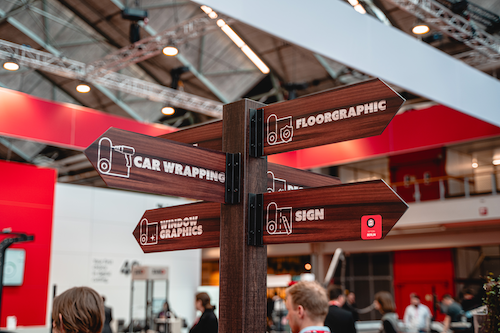Sara Horlock, Group Sales Manager, FESPA, shares some of the key trends within the signage industry, such as sustainable signage, as well as interactive and smart displays. As with most industries, sustainability is still making waves within the signage industry with demand for more environmentally friendly alternatives for materials and inks.
This demand is driven by increasing environmental awareness from customers and brands who are seeking solutions that align with sustainability goals, as well as changing regulatory frameworks.
A PwC 2024 Voice of Consumer Survey found that 80% of consumers are willing to pay more for sustainably produced or sourced goods, prompting businesses to adopt more sustainable practices in their signage solutions. These include sustainable and recyclable substrates such as wood, bamboo and recycled acrylic and aluminium and more eco-friendly inks.
The growth for more environmentally friendly solutions is consequently fuelling the soft signage market due to fabric-based materials requiring less raw material, generating less waste compared to traditional signage options and having lower energy consumption during production and transport.
And, it’s not just traditional signage that is adopting sustainable initiatives – it’s digital signage too. Due to its low power consumption and long lifespan, businesses are increasingly adopting energy-efficient LED displays as part of their displays.
Due to advancements in technology and more innovative substrates, sustainable signage is only going to continue to develop. We are already seeing the emergence within the industry of more novel substrates including materials made from mushrooms which are 100% biodegradable and compostable.
Interactive and smart signage, which leverage digital technology to enhance user engagement, are experiencing rapid growth in the signage market due to adoption across multiple sectors and technological advancements, including AI, voice and touchscreen interaction, item detection and facial recognition.
The benefits to brands of using interactive and/or smart signage is that they enhance the customer experience and create an innovate way to engage with the end-user. By using touchscreens and motion sensors, brands are making signage more engaging by creating a new touchpoint with the customer. Retailers are adopting this type of technology to engage shoppers in-store, allowing them to browse products or access additional product information, which not only helps to boost customer dwell time but also provides an engaging retail experience for the customer.
Smart signage goes one step further than interactive displays and can collect data on user interactions and engagement levels. This means that brands can improve strategies and marketing campaigns based on real-time data and customer behaviour patterns.
A big benefit of interactive and smart displays is that they can connect with multiple platforms, including mobile apps and social media for an integrated brand experience.
AI is playing a big role in the growth of intelligent displays by tailoring content dynamically based on real-time data, user behaviour and external conditions. By analysing these factors, AI will adjust the signage content to match the audience and situation. For instance, by using AI technology, fast food outlets could adjust their menus during peak times to promote items that are quicker to prepare, to help reduce customer wait times while also streamlining operations. Retailers could also tailor in-store promotions based on real-time shop or stock conditions.
Both sustainability and technology advancements such as AI are keys areas of discussion across the signage industry at present, and both provide increased opportunities for sign-makers to grow their businesses and meet demands from customers and brands.
At this year’s European Sign Expo 2025, sign-makers and visual communication experts will be able to see a plethora of exhibitors showcasing the latest in signage, whether that’s traditional signage including LED, neon and lightboxes to digital signage including the latest technology innovations. The event will open its doors at Messe Berlin, Germany (6-9 May).
Visitors will also have access to FESPA Global Print Expo where they can see how combining signage with digital and print media can amplify their business and create powerful, integrated results. This year’s Personalisation Experience will also demonstrate the power of customisation through expert-led sessions and real-life customer stories, inspiring sign-makers on how they can integrate personalisation-enabling technologies into their sign projects.
EUROPEAN SIGN EXPO
www.europeansignexpo.com















